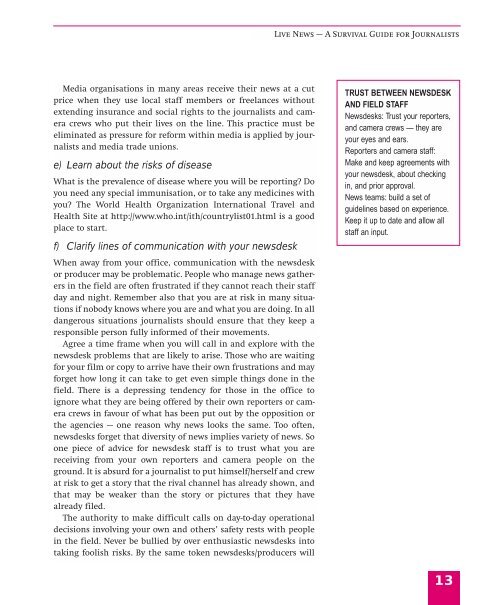Live News - A Survival Guide - International Federation of Journalists
Live News - A Survival Guide - International Federation of Journalists
Live News - A Survival Guide - International Federation of Journalists
- No tags were found...
Create successful ePaper yourself
Turn your PDF publications into a flip-book with our unique Google optimized e-Paper software.
<strong>Live</strong> <strong>News</strong> — A <strong>Survival</strong> <strong>Guide</strong> for <strong>Journalists</strong>Media organisations in many areas receive their news at a cutprice when they use local staff members or freelances withoutextending insurance and social rights to the journalists and cameracrews who put their lives on the line. This practice must beeliminated as pressure for reform within media is applied by journalistsand media trade unions.e) Learn about the risks <strong>of</strong> diseaseWhat is the prevalence <strong>of</strong> disease where you will be reporting? Doyou need any special immunisation, or to take any medicines withyou? The World Health Organization <strong>International</strong> Travel andHealth Site at http://www.who.int/ith/countrylist01.html is a goodplace to start.f) Clarify lines <strong>of</strong> communication with your newsdeskWhen away from your <strong>of</strong>fice, communication with the newsdeskor producer may be problematic. People who manage news gatherersin the field are <strong>of</strong>ten frustrated if they cannot reach their staffday and night. Remember also that you are at risk in many situationsif nobody knows where you are and what you are doing. In alldangerous situations journalists should ensure that they keep aresponsible person fully informed <strong>of</strong> their movements.Agree a time frame when you will call in and explore with thenewsdesk problems that are likely to arise. Those who are waitingfor your film or copy to arrive have their own frustrations and mayforget how long it can take to get even simple things done in thefield. There is a depressing tendency for those in the <strong>of</strong>fice toignore what they are being <strong>of</strong>fered by their own reporters or cameracrews in favour <strong>of</strong> what has been put out by the opposition orthe agencies — one reason why news looks the same. Too <strong>of</strong>ten,newsdesks forget that diversity <strong>of</strong> news implies variety <strong>of</strong> news. Soone piece <strong>of</strong> advice for newsdesk staff is to trust what you arereceiving from your own reporters and camera people on theground. It is absurd for a journalist to put himself/herself and crewat risk to get a story that the rival channel has already shown, andthat may be weaker than the story or pictures that they havealready filed.The authority to make difficult calls on day-to-day operationaldecisions involving your own and others’ safety rests with peoplein the field. Never be bullied by over enthusiastic newsdesks intotaking foolish risks. By the same token newsdesks/producers willTRUST BETWEEN NEWSDESKAND FIELD STAFF<strong>News</strong>desks: Trust your reporters,and camera crews — they areyour eyes and ears.Reporters and camera staff:Make and keep agreements withyour newsdesk, about checkingin, and prior approval.<strong>News</strong> teams: build a set <strong>of</strong>guidelines based on experience.Keep it up to date and allow allstaff an input.13
















